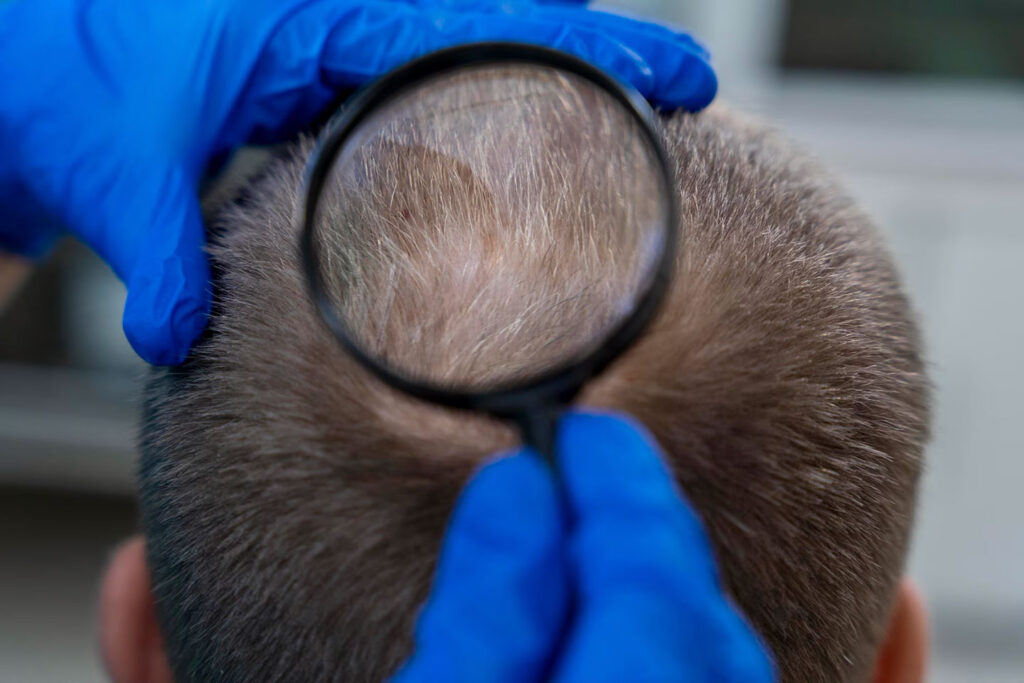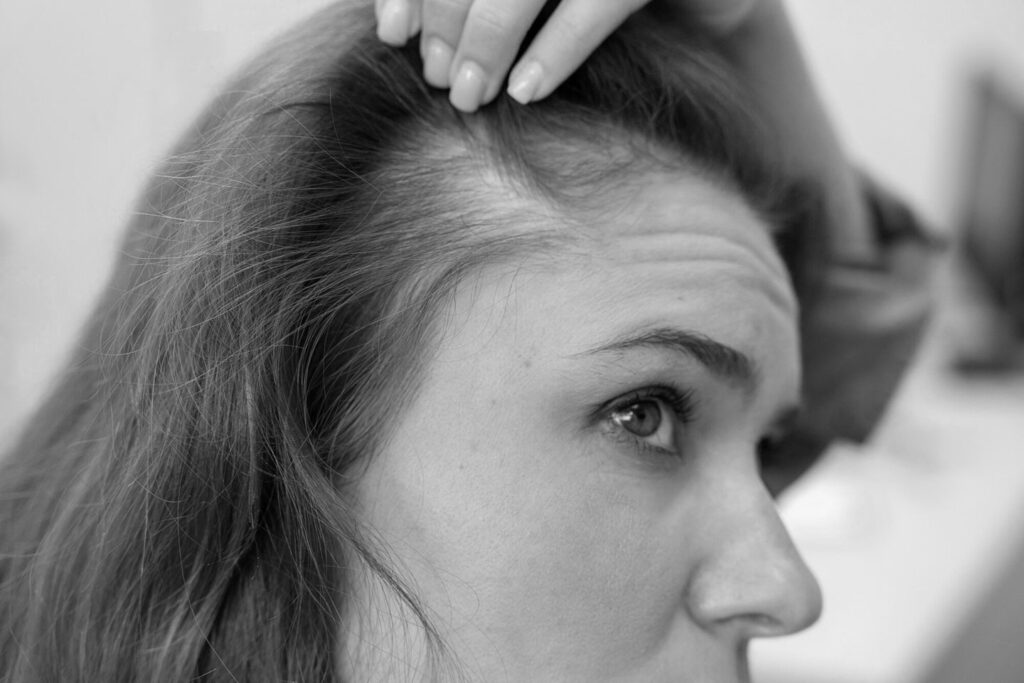What is scarring alopecia?
Cicatricial alopecia (or scarring alopecia) groups together diseases in which inflammation destroys the hair follicle and leaves a microscopic scar. Unlike non-scarring alopecia, here the hair “factory” is lost: the follicle. Therefore, the objective of treatment is to stop the inflammation and stabilize the disease; Hair already lost in scarred areas does not grow back.
Difference between scarring and non-scarring alopecia
- Follicle: destroyed and replaced by scarring vs. preserved.
- Prognosis for spontaneous regrowth: no vs. yes if the cause is treated.
- Therapeutic objective: stop inflammation and outbreaks vs. stimulate growth and correct reversible causes.
Key difference: In scarring alopecia, the follicle is destroyed and hair does not regenerate; in non-scarring alopecia, the follicle persists and can be recovered with treatment.
Most common causes and types

Cicatricial alopecia can be primary (inflammation attacks the follicle) or secondary (burns, severe infections, radiation therapy, trauma). Among the most common primary forms seen in clinical practice:
- Lichen planopilaris (LPP) and frontal fibrosing alopecia (FFA): hairline recession, sometimes eyebrow loss, burning, or itching. Combined anti-inflammatory treatment.
- CCCA (Central centrifugal cicatricial alopecia): begins at the crown, is more prevalent in women of African descent, and progresses concentrically. Early treatment improves the prognosis.
- Folliculitis decalvans: pustules, crusts, pain, and tufting (tufted hairs). Usually requires antibiotics and immunomodulation; there are new European consensus reports with advanced options in refractory cases.
- Discoid lupus erythematosus and pseudopelade of Brocq:chronic atrophic scarring plaques. (Diagnosis based on clinical examination, trichoscopy, and biopsy.)
Central idea: There is no single “type” of scarring alopecia nor is there a universal protocol; the plan is individual and depends on the subtype, activity, and symptoms.
Warning signs: when to consult now
Checklist of warning symptoms (eligible for featured snippet):
- Itching, burning, or pain on the scalp.
- Persistent redness, blisters, crusting, or scaling.
- “Shiny” areas or with absent pores.
- Plaques that grow or an active inflamed border.
Eyebrow loss or rapidly receding hairline.
If you identify two or more, ask for a dermatological diagnosis without delay. Starting treatment early reduces the risk of permanent progression.
How is scarring alopecia diagnosed?
At D’Atri we combine:
- Directed clinical history (symptoms, cosmetic habits, traction, straightening, extensions).
- Trichoscopy to evaluate pores, perifollicular scales, tufts.
- Scalp biopsy when subtype and activity confirmation are needed.
- Laboratory-oriented (e.g., autoimmunity, thyroid, deficiencies) as appropriate.
Thebiopsy and expert evaluation are crucial for choosing the therapeutic regimen and measuring activity.
Scarring alopecia treatment: what works and why timing matters
Goals:
- Suppress inflammation to slow follicular destruction.
- Relieve symptoms (itching, pain).
- Stimulate remaining hair when possible.
Common tools according to subtype and activity
- High-potency topical corticosteroids and/or intralesional infiltrations for active flares.
- Antibiotics with anti-inflammatory effects (e.g., doxycycline, minocycline) for controlled periods.
- Topical calcineurin inhibitors as steroid sparing.
- Antimalarials (hydroxychloroquine) or other systemic immunomodulators in selected LPP/FFA.
- FFA management: combination therapies; topical minoxidil as an adjuvant, and in some cases 5α-reductase inhibitors as directed.
- Folliculitis decalvans:antibiotic regimens (tetracyclines, clindamycin+rifampicin combinations), corticosteroids, and, in refractory cases, advanced optionsevaluated by European committees (photodynamics, biological agents such as adalimumab, JAKi) in specialized centers.
- Minoxidil topical/oral in low doses as a complement to promote viable hair, if there are no contraindications.
Key fact: early treatment can prevent the alopecia area from continuing to grow and sometimes achieve partial regrowth in undestroyed follicles, especially in CCCA if started early.
Is PRP useful or Mesotherapy?
Regenerative therapy can be considered as an adjuvant in selected cases to modulate symptoms and scalp quality, never as a substitute for inflammation control. The indication is decided after confirming the subtype and activity.
Hair implant in scarring alopecia?
Prevention and protective habits
Although many forms are not completely preventable, you can reduce triggersand protect your scalp:
- Avoid chronic traction (tight braids, high ponytails, extensions).
- Minimize heat and harsh chemicals (repeated straightening, bleaching).
- Use gentle shampoos and space out irritating treatments if you have a sensitive scalp.
- Photoprotectionof the scalp in the open air.
Consult early if you experience itching, pain, pustules, or receding forehead. At CCCA, early treatment changes the outcome.
Quick Action Guide
- You notice growing plaques, burning or pustules: I asked for a priority appointment.
- Accurate diagnosis with trichoscopy and, if necessary, biopsy.
- Personalized anti-inflammatory plan + adjuvants.
- Monthly/quarterly check-up to measure activity.
- Hair transplant evaluation only if the disease is stable and inactive.
Frequently asked questions about scarring alopecia
Why choose D'Atri Hair Medicine

At D’Atri Medicina Capilar we combine 15+ years of experience, advanced trichoscopy, targeted biopsy when appropriate and a teaching medical team that trains professionals in the FUE Technique. Our priority is to take care of your hair health, stabilize the condition, and plan, if appropriate, a hair transplant at the right time for natural and safe results.
Book your personalized diagnosis at D’Atri and receive a clear plan for your case.

